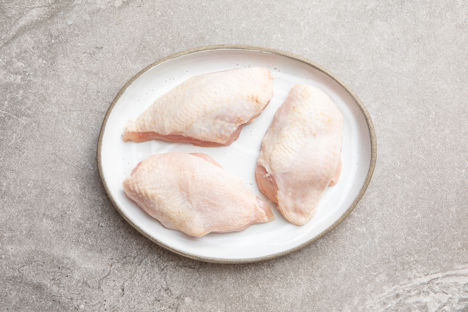Chicken breast is a popular cut thanks to its leanness and versatility. If cooked correctly, the meat can be tender and juicy. However, its lack of fat means it can also be prone to dryness. Buying skin-on chicken breasts offers extra flavour and fat from the skin, which can be crisped up either on the breast or separately, to use as a garnish for a salad, in a sandwich or to top more substantial dishes such as chicken risotto.
What to look for when buying chicken breasts
We always recommend buying free-range chicken, due to the welfare concerns associated with cage-reared birds. The flavour of free-range chicken will also be far superior. We mainly consume the Sussex breed in the UK, but there are several other breeds worth looking out for, including the Bresse, Cornish hen and Black Leg.
How to cook chicken breast without drying it out
There are a few simple ways to cook chicken breast without it drying out, including poaching, steaming, pan frying and grilling (among others!) The key to keeping chicken breast succulent and juicy is to make sure you don’t overcook it. An instant read probe thermometer can be helpful here - chicken is fully cooked at 75ºC, which means you should remove it from the heat source at around 72ºC, as the internal temperature will continue to rise a little after cooking.
How to brine chicken breast
Brining a chicken breast means you eliminate the chances of dry meat. However, it does need a little advance planning. Brining is a particularly useful technique if you want to deep fry your chicken breast to make a fried chicken sandwich, for example, but it can also be handy for simply ensuring you get perfectly juicy chicken breasts, every time. The quantity of salt needed for a brine is based on a percentage of the total water weight and you will see different percentages used in different recipes. The best way to find your preference is to experiment! Here’s how to make a simple brine for chicken breasts.
Metric
Imperial
- 60g of sea salt
- 1l water
- 1 sprig of chopped rosemary
- 4 garlic cloves, bashed with the side of a knife
- 4 large skinless chicken breasts
Combine the salt and water and whisk until the salt is dissolved
Add the rosemary and garlic cloves
Place the chicken breasts into a container and pour over the solution, making sure they are fully submerged
Transfer to the fridge for 2 hours
Drain the brine and pat the chicken breasts dry before cooking
How to deep fry chicken breast
If you’ve brined a chicken breast, it’s quite likely you’ll also be breadcrumbing it for a chicken burger or chicken Kyiv. We like to double coat our chicken breast in breadcrumbs, to ensure it’s well sealed before frying. It’s also important to make sure your oil is hot enough - around 180ºC - before frying, otherwise the chicken will soak up the oil rather than cooking in it.
How to BBQ chicken breast
How to pan fry chicken breast
One of the most popular methods of cooking chicken breasts is pan-frying. It’s quick, easy and will ensure a crisp, golden skin. Our video shows you how to cook chicken breasts like a professional chef, ensuring accurately cooked meat that’s basted with butter for maximum flavour.

Once your chicken breasts have been pan-fried they can be used in many dishes. We sometimes cook our chicken breasts under a weight, such as a heavy pan, to ensure the skin becomes super crisp and golden; they can be cooked mostly skin side down, then flipped over for a minute or so to finish cooking through.
How to poach chicken breast
While it may sound a little dull, poaching is a wonderful way to gently cook chicken breasts to retain the softness and delicacy of the meat. Salt and flavourings such as herbs, spices or aromatics such as garlic can be added to the poaching liquor, which itself can add flavour in the form of stock. It’s crucial to cook the chicken breast gently, as cooking it in aggressively boiling water will make the meat tough.
How to sous vide chicken breast
How to steam chicken breast
Steamed chicken breast may sound a little unappealing but it’s actually a lovely way to delicately cook this lean piece of meat. The key is to steam the chicken breast gently to prevent it becoming tough.
A versatile cut
The versatility of chicken breast is one of its main selling points and there are so many options for flavouring this adaptable meat. Try one of our recipes below or browse our full archive of chicken breast recipes for inspiration.
Get in touch
Please sign in or register to send a comment to Great British Chefs.



